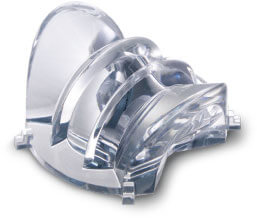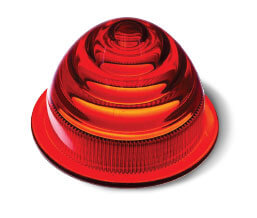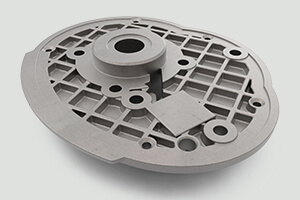Reducing Component Weight for Automotive Applications
Manufacturing process and material considerations for lightweighting
Increasing smog and pollution, fluctuating fuel prices, environmental concerns over fracking and offshore drilling—there are many reasons to increase fuel efficiency in both passenger and commercial vehicles. One of the best ways to do this is by reducing vehicle weight. Lighter cars mean consumers use less fuel, resulting in cleaner air and reduced dependence on irreplaceable fossil fuels. Simply put, vehicle lightweighting makes good sense.
Automotive manufacturers, and their suppliers, will be fighting a continuous uphill battle to design and produce lighter, more efficient automotive components for decades to come. European and worldwide regulatory, market-driven, redesign initiatives are creating a perfect storm of product development activity for automotive suppliers. Even in the commercial sector, countless opportunities exist to simplify designs, reduce weight and use less material, all of which benefits consumers and the planet alike.
A move to lighter weight products and components often begins with prototyping, where material and manufacturing process selection is paramount.
A Move to Magnesium
One thing that should be remembered before embarking on any lightweighting project is to look at it in bitesize chunks. Unless you’re creating a fuel-efficient redesign of the transmission housing for an 18-wheeler, it will be difficult to significantly reduce the weight of a single part. Instead, a small weight reduction on each component of a domestic vehicle is the logical solution to reducing vehicle weight. The rear view mirror used in domestic cars, for example, was once heavy enough to hammer a nail. Today, most rear view mirrors are made of a magnesium frame and a plastic shell, yet retain the same strength and functionality as their corpulent predecessors. The trick is to develop products that fulfil cost and duty requirements but use alternate materials and clever designs to reduce weight.
Fortunately for designers and engineers, today’s array of prototyping materials and advanced manufacturing technologies offer innovative
opportunities for iterative, even parallel-path design testing. For example, when considering a suitable material for designing a lightweight headlight bezel, magnesium might be a good place to start.
With a density of 1740kg / m3, magnesium is the lightest of all structural metals, and has the highest strength-to-weight ratio as well. It carries a proven track record in the automotive, aerospace, medical, and electronics industries,
and is used in everything from fuel tanks to gearboxes. And because magnesium is one of the most abundant minerals in the human body, it is not only biocompatible but also biodegradable, so it is a logical choice for self-dissolving screws, pins and other implants requiring greater strength than those made of biodegradable polymers. Magnesium is routinely milled into a variety of prototype parts. Compared to aluminium, the lightweighting runner-up, it is more expensive per pound, but that cost delta is offset somewhat by magnesium’s 33% lighter weight and comparable strength. It’s also easily machined although some care must be taken to control fine chips and metal particles, as these can be flammable in oxygenrich environments.
For those concerned over fires with magnesium components in the field, don’t be—magnesium is everywhere. The Volkswagen Beetle sported a magnesium alloy engine block for decades, and BMW started using magnesium for its N52 sixcylinder crankcases and cylinder head covers in 2005. The AZ31 and AZ91 grades of magnesium alloy used at Protolabs are even weldable, and have melting points of roughly 900-degrees F (482 C). Unless you’re designing a lightweight furnace liner, magnesium is an excellent choice for many different components. Worldwide, automotive companies are turning to magnesium for its strength, light weight and—because it can be extracted from seawater—its abundant supply.
Plastic Alternatives
Magnesium and aluminium are excellent alternatives to steel for lightweighting, yet thermoplastic and thermoset materials are robust possibilities as well. An extensive selection of glass-, metal- or ceramicfilled polymers as well as liquid silicone rubber (LSR) can also be used to replace metal parts, thus reducing product cost and weight while improving durability.


• Polypropylene (PP) is a flexible, fatigue resistant family of thermoplastics commonly used in automotive interiors, battery cases, boat hulls, prosthetics, and other products requiring toughness and light weight. The different grades of polypropylenes are grouped as homopolymers, impact copolymers, or random copolymers, with the latter two considered engineering-grade materials, offering superior strength-to-weight ratios and good impact resistance even at cold temperatures. All polypropylenes are heat-resistant, with melting points in the neighbourhood of 300-degrees F (149 C). They’re also microwavable, and moulded parts can be left translucent or coloured, making PP a favourite in food storage containers and other types of lightweight packaging.
• Polyethylene is offered in both high-density (HDPE) and low-density (LDPE) versions. HDPE has uses and mechanical properties similar to polypropylene, but is more rigid and offers greater resistance to warping. Because of its low cost and relatively high strength, it’s often used in underground pipes, water tanks and chemical storage containers. HDPE’s lower density, more flexible counterpart LDPE sees use in squeeze bottles, plastic wrap and playground slides. Both materials are suitable for use where toughness and low weight is needed—such as a glove box or a cold air
intake.
• ABS is another thermoplastic with exceptional impact resistance and toughness. It is a lightweight alternative to metal in dashboard trim, electronics enclosures, hubcap covers and other such automotive applications. Injectionmoulded ABS is also available in either flameretardant or antistatic grades in a rainbow of colours, opening the door to a staggering number of lightweight consumer, medical and electronics products. Chrome-plated ABS hubcaps are used on a large number of domestic vehicle reduce vehicle weight, as are ABS grills and ABS fender flares. Finally, the chassis of the world’s first 3D-printed automobile—the STRATI—produced onsite during the 2014 International Manufacturing Technology Show, was made of carbon-fibre reinforced ABS. It weighs just 499kg.
• Polycarbonate (PC) is very thermoformable, and is frequently shaped into see-through architectural panels, lenses for glasses, industrial computer screens, and other products where glass is unsuitable due to weight or breakage concerns. It has 250 times the impact resistance but only half the weight of regular glass, which is why “bulletproof glass” and aircraft windows are actually made of polycarbonate or its slightly more flexible cousin, acrylic. On the additive manufacturing side of the house, Protolabs offers 10% glassfilled polycarbonate-mimic Accura 60 plastic from 3D Systems for functional prototypes with properties similar to commercial-grade PC, and Accura 5530 or ceramic-filled DSM Somos NanoTool for high-temp aerospace and automotive applications. Similar grades of PC are available for machining or injection moulding.
• Nylon is also frequently filled with mineral or glass fibres to improve stiffness-to-weight ratios and improve mechanical properties. This makes it one of the strongest plastics available at Protolabs and—because nylon is self-lubricating, thermally stable and very wear-resistant—is an excellent candidate for sprockets, fan blades, gears, latches, manifolds and bearing surfaces. It’s also very light, with 15% the weight of steel and 40% of aluminium. Protolabs offers selective laser sintering (SLS) of several engineering-grade nylons, which can be used for functional testing of prototypes prior to machining or injection moulding. One of these is Nylon 11, a material that works well for living hinge designs as used in hose and wire clips, washer fluid caps and other automobile components.
• Acetal, more commonly called by its trade name Delrin, is a regular go-to material for machined prototypes. It is strong and stiff without the need for nylon’s glass-fibre reinforcement (although glass is sometimes used to increase Delrin’s stiffness and creep resistance), and is regularly called upon to replace precision metal parts in a range of industrial and consumer products: electrical and fuel system components, power transmission parts such as gears, bushings, and bearings, and other high-performance parts can be milled or injection moulded from different grades of acetal copolymer or homopolymers stocked at Protolabs.
• Liquid silicone rubber, or LSR, is a surprising but versatile material for many moulding applications. It starts out as a two-part thermoset compound, which is mixed at low temperatures and then injected into a heated mould. Upon curing, LSR becomes strong yet flexible, and is suitable for gaskets, lenses, connectors, and other parts that require excellent thermal, chemical, and electrical resistance. Wiring harnesses, panel buttons, spark plug boots—these are but of few of the places LSR can be found in modern vehicles. That’s a lot of plastic.
Weighing the Manufacturing Options
Despite the flexibility in material options, it’s a good idea to understand what material peg fits into which manufacturing hole. Machined prototypes were once produced on hand-cranked milling machines and engine lathes. They were largely made of steel, brass, or aluminium and took weeks to deliver. Protolabs has automated that same basic process to the extent that electronic part designs can literally be uploaded one day and delivered the next, and made from nearly every material previously mentioned. Protolabs’ CNC machining centres mill prototypes from solid blocks of metal and plastic roughly the size of a thick encyclopaedia, and lathes with live tooling cut parts about as large as a flower vase. Both processes hold tolerances to +/- 0.1mm or better, depending on part geometry.
A growing method to rapidly manufacture magnesium parts is through injection moulding (also known as thixomoulding, which is available
from Protolabs’ US facility). Here, chips of magnesium feedstock are loaded into the hopper of a moulding press. Heat and agitation are then
applied, thus bringing the magnesium payload to a semisolid state, whereupon it is “shot” under pressure into a mould cavity via a feeder screw. The result is that fully functional magnesium components can be produced in low volumes at a fraction the cost of “production-tooled” parts.
Many manufacturing engineers associate magnesium with die casting, as this has long been the traditional, high-volume method of forming this ubiquitous metal. Magnesium injection moulding offers a number of distinct advantages over its more mature counterpart. Thixomoulding is essentially a “cold” process, operating just short of magnesium’s melting point. Because of this, there is less shrinkage and warp compared to die-cast parts, and the mechanical properties of thixomoulded parts are generally better as well. The cooler process also requires less sophisticated tooling, as there is little need for cooling channels. And since the magnesium slurry is fed into the mould at very high pressure—in some cases twice that of die casting—very fine part details are produced. All things considered, thixomoulding is the clear choice for many prototyped or low-volume magnesium components.
Another mature prototyping process is stereolithography (SL), the grandfather of all additive manufacturing technologies. Protolabs uses SL to print parts from nine grades of polymer across three primary groups: ABS, polycarbonate and polypropylene. It’s important to point out that these materials mimic plastics and are not rated for functional product use. SL does, however, produce highly accurate prototypes, and is a logical first step for an initial “touch and feel” of lightweighted concept parts. And for testing the form and fit of products destined for die casting, Protolabs offers SLArmor, a nickel-plated, ceramic-filled additive material that is very light yet still strong enough to pinch-hit for metal in certain cases, and an ideal solution for many lightweighting applications.
Next on the 3D printing list is Selective Laser Sintering, which is limited to four types of engineering-grade nylon materials at Protolabs, two of which are reinforced for high-heat applications and greater structural integrity. Like all additive processes at Protolabs, SLS employs a laser to draw each part layer. Part features are somewhat less accurate than those produced by SL, but still plenty good for functional testing. Of all the plastic materials available at Protolabs, glass-filled nylon is one of the most popular materials with automotive manufacturers, largely due its low cost and toughness, although glassfilled polycarbonate comes in a close second. Because of this, SL and SLS are both very suitable for prototyping lightweight parts.
Another increasingly used additive manufacturing process offered is DMLS, or direct metal laser sintering. DMLS melts layers of metal powder, as thin as 0.02mm (20 microns) at Protolabs, to create complex, 98% dense part shapes that are often impossible to manufacture otherwise. It is highly accurate with tolerances of +/- 0.1mm to +/- 0.2mm plus an additional +0.005mm. that are typically achieved on well-designed parts.
At Protolabs, DMLS works with aluminium and titanium, so is an obvious contender for manufacturing lightweight parts, but is also
used with 316L and 17-4PH stainless steel, cobalt chrome alloy, and Inconel, super strong metals known for their extreme heat resistance and durability rather than weight reduction. You might be wondering how an additive process that uses metals such as these has made its way into a lightweighting white paper. But here’s the thing: DMLS can fabricate metal parts that, until now, were nothing more than a designer’s fantasy. Parts more hollow than a chocolate Easter egg, Escher-like curves and spheres, ultra-thin walls and spider web-like lattices, consolidation of multipart assemblies into a single sintered component—these are a few of the lightweighting possibilities DMLS (as well as SL and SLS) can offer.
DMLS is slower than other additive processes, and more expensive—if your part design can be efficiently machined or moulded, DMLS may not be the right manufacturing method. But for complex assemblies, improbable shapes, or parts where small amounts of superalloy go a long way, DMLS might be just the ticket to reduce part weight and cut manufacturing costs. Lastly, DMLS isn’t limited to prototype quantities—given a small, complex workpiece too difficult
or expensive to manufacture via conventional methods, DMLS is often a viable alternative for low-volume production volumes in the thousands.
Final Considerations
Consider designing a water pump. Glass-filled polycarbonate would make a strong, lightweight impeller, the brass drain plugs could easily be replaced by ABS or polypropylene plastic, and nickel-plated, ceramic-filled NanoTool material might be used for the backplate. In each of these cases, you could use SL to 3D print various design iterations for form and fit testing, followed by having a dozen or so prototypes machined for functional testing, and then easily move to several thousand injection-moulded parts. In addition, the cast iron pump housing could be replaced with one made of magnesium. Sorting through all the different possibilities is one of the biggest challenges with lightweighting. That’s because improvements to product design in the automotive world isn’t a matter of grabbing whatever material weighs the least and replacing the legacy steel or iron used previously. Plastic parts that will eventually be mass-produced via injection moulding must be designed with the correct draft angles and wall thicknesses up front. Ejector pins must be considered, as should
areas with undercuts, tight internal radii, and a host of other details that can make or break your lightweight part.
Additional factors to consider before embarking on lightweighting design:
• Support ribs and honeycombed sections reduce part weight while retaining structural integrity, especially with injection-moulded thermoplastic parts.
• Magnesium parts are 33% lighter than aluminium and a whopping 75% lighter than steel.
• Magnesium injection moulding a fast and easy stepping stone to high-volume die-casted magnesium products.
• A thorough analysis of projected part volumes early on can avoid costly redesigns when quantities increase.
• Even though stainless steel, cobalt chrome and Inconel weigh more than aluminium and magnesium, DMLS technology can make these “heavy” metals a strong, weight-efficient alternative to lighter materials.
• Don’t be scared off by the higher expense of glass-filled plastics, as their greater strength can lead to significant weight reduction.
• When designing moulded parts, always use the online mouldability analysis tools offered by Protolabs (whether or not you order parts through them).
There are many good reasons for lightweighting. Designing lighter, stronger, and more costeffective manufactured products is good for everyone, and provides a competitive edge to the companies that produce them. The drive to greater fuel efficiency in cars and trucks will continue to be the Holy Grail of these industries, a goal that rests on a daunting three-legged stool of limited fossil fuels, increasing greenhouse gases, and growing government regulations.
The good news is that, considering the array of prototyping and low-volume production services available at Protolabs—along with its in-house expertise—you have many different resources to help reduce part weight. If you have any questions regarding materials, manufacturing processes or design, please contact a Protolabs’ customer service engineer at [email protected] or +44 (0)1952 683047
-


